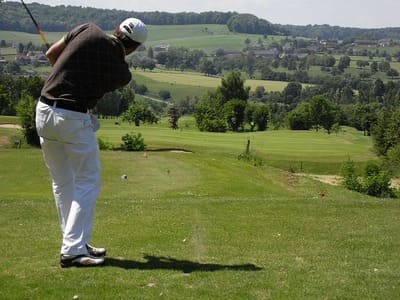Ah, the serene beauty of a golf course, the distant sound of birdsong, the scent of freshly mown grass, and the occasional clatter of clubs being pulled from the bag. Golf is a game of precision, strategy, and sometimes, a touch of the unexpected. But what is a provisional shot in golf?
Have you ever found yourself standing on the tee, sending your ball into the wild unknown, and thought, “I wish I had a do-over button right now”? Well, my fellow golf enthusiasts, you’re in luck! Because we’re about to unravel the mystery of that magical Mulligan – the Provisional Shot in golf. It’s the ultimate get-out-of-jail card, the golden ticket to redemption when your first shot takes an unexpected detour into the rough, the water, or the great unknown.
In this blog post, we’re diving into the world of Provisional Shots – what they are, when to use them, and why they can be a game-changer when you’re walking the hallowed fairways. So, dust off your scorecard, polish your club, and get ready to uncover the secret weapon that might just save your golf game from the brink of disaster. Get ready for the inside scoop on the Provisional Shot – your insurance policy against those notorious “lost balls”!
The Definition of a Provisional Shot
A provisional shot is a term commonly used in the game of golf. It refers to a second shot that a golfer may choose to play if their first shot is in a potentially lost or out of bounds area. The purpose of a provisional shot is to save time. And to avoid the need to walk back to the original spot, re-tee, and take a penalty stroke. Instead, the golfer can hit another shot from the same spot as their first shot and search for the original ball later.
When a golfer decides to play a provisional shot, they must announce it to their playing partners by saying “I’m playing a provisional.” This announcement is crucial to avoid any confusion later on. The provisional ball is typically marked with a different colored ball or a uniquely identifiable mark. Such as a marker pen line or a symbol. By marking and identifying the provisional ball, it becomes distinguishable from the original ball. This helps players correctly determine which ball to play if both are found.
Playing a provisional shot can be a strategic move that can save strokes and time on the golf course. However, it’s important to understand the rules and guidelines that govern these shots to ensure a fair game. In the following sections, we will explore when and why a provisional shot may be needed. As well as the proper way to declare and execute it. We will also delve into the penalty and scoring implications of a provisional shot. Also we’ll provide expert tips and techniques for a successful outcome.
When and Why is a Provisional Shot Needed
A provisional shot is needed in golf when a player believes their original ball may be lost or out of bounds. This situation typically arises when the ball is hit wildly. Perhaps into a hazard, thick rough, or an area where it may be difficult to locate. By playing a provisional shot, the player has a backup ball in case the original cannot be found. This allows them to avoid the time-consuming process of returning to the previous spot and re-playing the shot. This improves the pace of play.
The need for a provisional shot is also driven by the rules of the game. According to the rules of golf, if a player fails to play a provisional shot after hitting their ball into a questionable area, they run the risk of incurring a penalty stroke. This can have significant implications for scorekeeping, especially in competitive situations. Therefore, a provisional shot provides a strategic advantage by keeping the player in play and reducing potential penalty strokes. It is an opportunity to mitigate the potential loss of the original ball and maintain control over the game.
The Rules and Guidelines for Playing a Provisional Shot
When it comes to playing a provisional shot, there are several rules and guidelines that every golfer should follow. First and foremost, it is crucial to understand that a provisional shot is only allowed if there is a possibility that the original ball may be lost outside of a water hazard or out of bounds. This means that the player must reasonably believe that the ball may not be found or is out of play.
Once the decision to play a provisional shot is made, the player should immediately announce their intention to fellow competitors or playing partners. They can do this by simply stating “I am going to play a provisional ball.” A verbal declaration is essential to ensure transparency and avoid confusion on the course. It is also important to note that the provisional ball must be played from the same spot as the original ball. Failure to comply with this rule could result in a penalty stroke.
Additionally, the player must take all the necessary steps to properly mark and identify the provisional ball. Such as using a different color or marking it with a unique identifier. This ensures that there is no confusion between the original ball and the provisional ball during the rest of the play.

How to Declare and Execute a Provisional Shot
When faced with a situation where a lost ball is a possibility, it is important to know how to declare and execute a provisional shot. To declare a provisional shot, simply announce to your playing partners that you intend to hit a provisional ball. It is crucial to use the keyword, “provisional,” to ensure everyone understands your intentions. This declaration should be made before leaving the tee box or the general area where the original shot was lost.
To execute a provisional shot, follow the same procedure as a regular shot. Approach the teeing ground or the area where the original shot was last seen. Align yourself properly, take your stance, and confidently strike the provisional ball. It is imperative that the provisional ball is played from the same spot. Or as near as possible to where the original ball was last played. Remember, the provisional ball becomes the ball in play if the original ball cannot be found or is out of bounds.
The Importance of Properly Marking and Identifying a Provisional Ball
When it comes to playing a provisional shot, one of the most crucial aspects is properly marking and identifying the provisional ball. This is essential to ensure the integrity of the game and avoid any confusion or penalties. The act of marking the ball allows players and officials to distinguish it from other balls on the course. This prevents any potential mix-ups or disputes.
Players can easily recognize their provisional ball by using a unique marking, such as a dot or a line. This marking becomes even more important if multiple players have hit provisional shots in the same area. By adhering to the proper marking guidelines, players can confidently proceed with their provisional shot without any ambiguity.
Identifying the provisional ball is equally significant in maintaining fair play on the course. Once the provisional shot has been played, it is crucial for players and their fellow golfers to easily identify and locate the provisional ball. In case the original ball is found and determined to be playable, the provisional ball becomes irrelevant. However, if the original ball is not found or is deemed out of bounds, the provisional ball comes into play. Therefore, properly identifying the provisional ball ensures that the correct ball is played by the rules of the game. By implementing clear marking and swift identification, players can navigate the intricacies of the provisional shot with confidence and integrity.
Understanding the Penalty and Scoring Implications
When it comes to golf, understanding the penalty and scoring implications of a provisional shot is crucial. A provisional shot is taken when a player believes their ball may be lost outside of a water hazard or out of bounds. By declaring and playing a provisional shot, the player can avoid the time-consuming process of returning to the original spot to replay the shot.
However, it’s important to note that playing a provisional shot comes with its own set of rules and consequences. According to the Official Rules of Golf, if a player opts to play a provisional ball and subsequently finds their original ball. They must abandon the provisional ball and continue play with the original ball. If the provisional ball is played from a spot closer to the hole, it results in a two-stroke penalty.
On the other hand, if the provisional ball is played from a spot farther from the hole, then the penalty is the distance covered by both the original ball and the provisional ball. Plus a one stroke penalty. Understanding these penalty rules is essential for golfers to make informed decisions when faced with the need for a provisional shot.
Key Factors to Consider before Deciding to Play a Provisional Shot
Many golfers are faced with a situation on the golf course that may require a provisional shot. It is important to carefully assess the circumstances before making a decision. One key factor to consider is the likelihood of finding your original ball. If you suspect that your ball may be lost or out of bounds, it is wise to play a provisional shot to avoid incurring penalty strokes. Another factor to weigh is the potential impact on your score. Taking a provisional shot can help minimize the damage if your original ball is indeed lost. This provides you with an opportunity to salvage your round.
Furthermore, it is crucial to evaluate the difficulty and risk associated with attempting a provisional shot. Factors such as the distance to the desired target area and the presence of hazards or obstacles. Even the level of confidence in executing the shot should be considered.
In some situations, playing a provisional shot may introduce even greater risks or require a difficult shot. This may influence your decision. It is essential to objectively assess the circumstances. This will help you determine whether playing a provisional shot is the best course of action to ensure the smooth flow of your game.

Expert Tips and Techniques for a Successful Provisional Shot
When it comes to playing a successful provisional shot, there are a few key tips and techniques that can greatly improve your chances of finding a favorable outcome. Firstly, it is crucial to stay calm and focused, even in high-pressure situations. Take a moment to gather yourself and assess the situation before executing the shot. Secondly, it is important to choose the right club for the provisional shot. Consider the terrain, distance, and any obstacles in your path before selecting the appropriate club. This will ensure that you have the best chance of hitting the ball accurately and with sufficient distance.
Another important technique for a successful provisional shot is maintaining proper body alignment. Positioning your feet, hips, and shoulders parallel to your target line will help you execute a straight shot. This can avoid many unnecessary curves or slices.
Additionally, it is recommended to aim for a specific target on the course, such as a tree or bunker. This gives you a clear line of sight and increase your chances of hitting a successful provisional shot. Remember, practice makes perfect, so spend time on the driving range honing your skills and developing a consistent swing. Incorporating these tips and techniques into your game will greatly improve your performance when playing a provisional shot.
Common Mistakes To Avoid
Properly executing a provisional shot can be a game-changer when it comes to navigating tricky situations on the golf course. However, there are a few common mistakes that many players make when attempting a provisional shot. One of the most significant mistakes to avoid is failing to announce and declare the provisional shot to your playing partners. Without proper communication, it can create confusion and potentially lead to disputes later on. It is crucial to clearly state that you are playing a provisional shot and indicate the reason why. Such as a lost ball or an out-of-bounds. This simple step ensures that everyone is aware of the situation and can help in locating the original ball if necessary.
Another common mistake is not accurately identifying and marking the provisional ball. When hitting a provisional shot, it is crucial to mark the spot where the ball landed or crossed a hazard, and place a distinguishing marker nearby. Failing to properly mark the provisional ball can lead to confusion and may result in the wrong ball being played. This obviously leads to penalties.
Take the time to use a different colored ball or a unique marker to ensure that there is no ambiguity when it comes time to determine which ball to play. Remember, the purpose of a provisional shot is to provide a backup option in case the original ball cannot be found. It is essential to treat the provisional ball with the same care and attention as the original.
FAQs
What is a provisional shot?
A provisional shot is an additional shot taken by a player when their original ball might be lost or out of bounds. It is played as a precautionary measure to save time if the original ball cannot be found.
When and why is a provisional shot needed?
A provisional shot is needed when a player believes their original ball may be lost or out of bounds. It is played to avoid the need to return to the previous spot and re-tee, saving time in case the original ball cannot be found.
What are the rules and guidelines for playing a provisional shot?
The rules state that a player must announce their intention to play a provisional shot before doing so. The provisional shot must be played from the same spot as the original shot or as close to it as possible. The player should also use a different ball to avoid confusion.
How do you declare and execute a provisional shot?
To declare a provisional shot, you must verbally announce that you are playing a provisional ball before hitting it. To execute the shot, use a different ball and play it from the same spot or as close to it as possible.
Why is it important to properly mark and identify a provisional ball?
Properly marking and identifying a provisional ball is crucial to avoid confusion with the original ball. Marking the ball with a different symbol or number helps distinguish it from the original ball.
What are the penalty and scoring implications of a provisional shot?
If the provisional ball is played, and the original ball is found and playable, the player must continue with the original ball. However, if the original ball is not found, the provisional ball becomes the ball in play, and the player incurs a stroke penalty.
What factors should I consider before deciding to play a provisional shot?
Some factors to consider include the likelihood of finding the original ball, the potential penalty strokes, the importance of time-saving, and the impact on your overall score.





